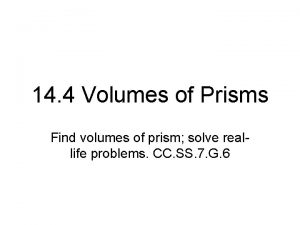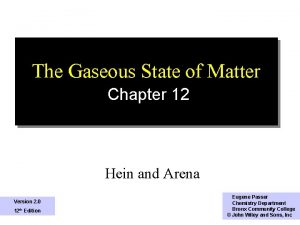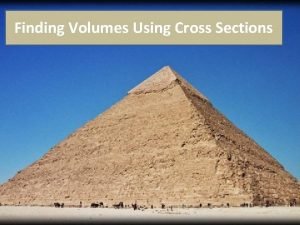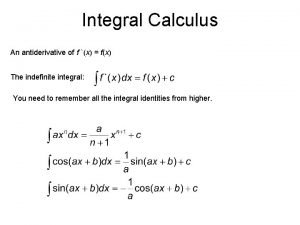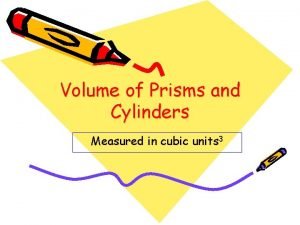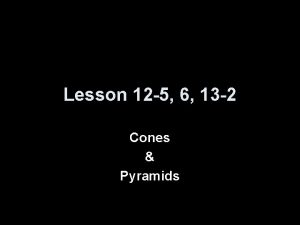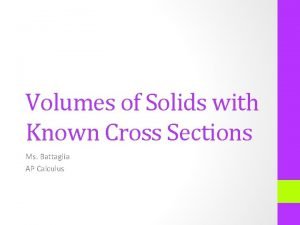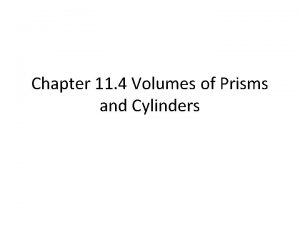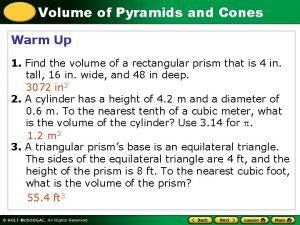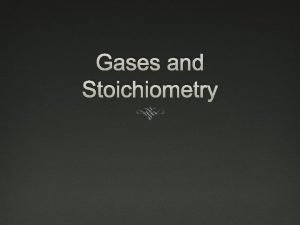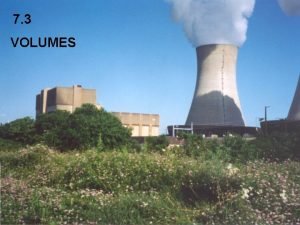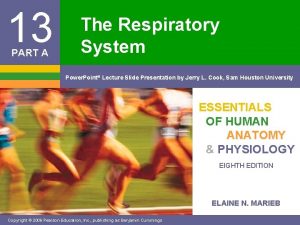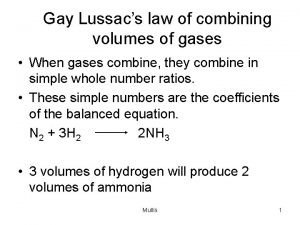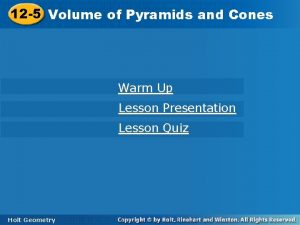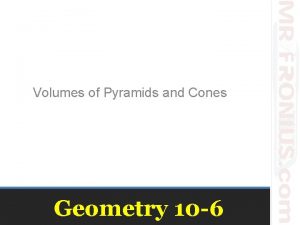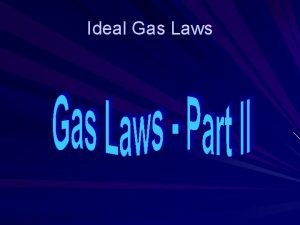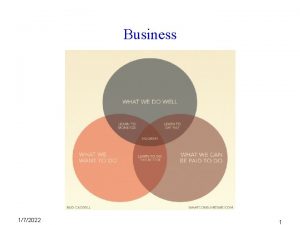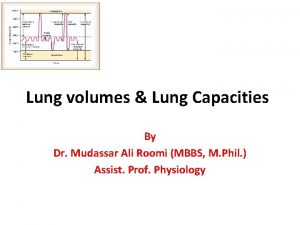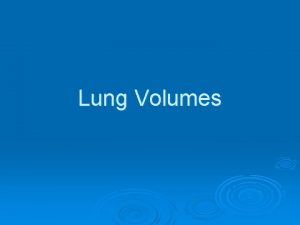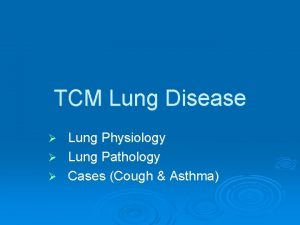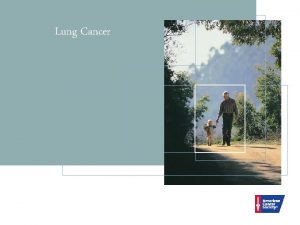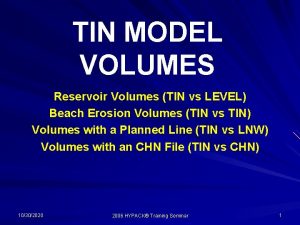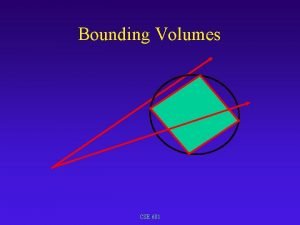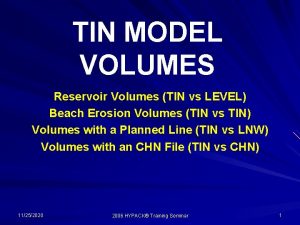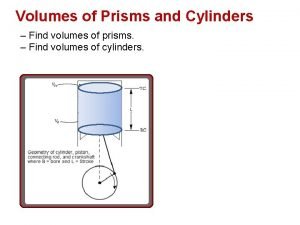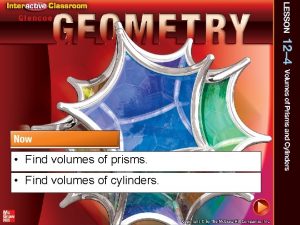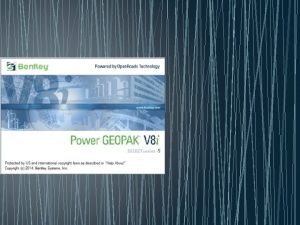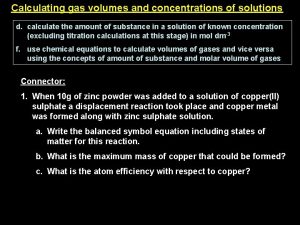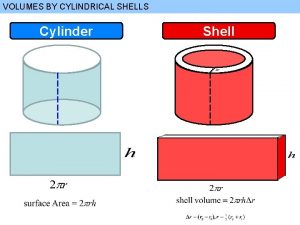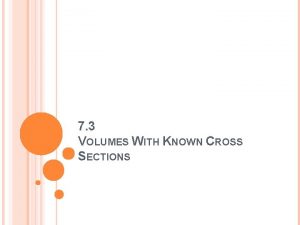Lung Volumes 172022 Lung Volumes 1 Lung Volumes





















- Slides: 21

Lung Volumes 1/7/2022 Lung Volumes 1

Lung Volumes Tidal volume 500 ml Anatomical dead space 150 ml Alveolar gas 3000 ml Pulmonary capillary blood 70 ml 1/7/2022 Total ventilation 7500 ml/min Frequency = 15 per min Alveolar ventilation 5250 ml/min Pulmonary blood flow 5000 ml/min Lung Volumes 2

Determination of Lung Volumes Recoding drum Mouth piece Water filled spirometer 1/7/2022 Lung Volumes 3

Lung Volumes Inspiration l 6 VC IRV IC TV 1. 7 l 1. 2 ERV 1. 1 0 TLC RV FRC Volume of air in the lungs can be subdivided into 8 components Most important • Tidal volume • Vital capacity • Functional residual • • Expiration 1/7/2022 Lung Volumes capacity Residual volume Total lung capacity 4

Tidal Volume Inspiration l 6 during breathing IC 1. 7 TLC l l 1. 2 ERV 1. 1 0 • Inspired or expired VC IRV TV Volume of air RV FRC It is about 500 ml One of the determinants of minute ventilation • Pulmonary ventilation Expiration • MV = TV * RR 1/7/2022 Lung Volumes 5

Inspiratory Reserve Volume IRV l Inspiration 6 IC 1. 7 1. 2 ERV 1. 1 0 • That can be taken in VC IRV TV Volume of air TLC • • by maximal inspiratory effort Over and above TV It is about 3000 ml FRC RV Expiration 1/7/2022 Lung Volumes 6

Expiratory Reserve Volume ERV Inspiration l 6 IC 1. 7 1. 2 ERV 1. 1 0 • That can be expelled VC IRV TV Volume of air FRC TLC • • by most powerful expiratory effort After tidal air has been expelled It is about 1100 ml RV Expiration 1/7/2022 Lung Volumes 7

Residual Volume Inspiration l 6 VC IRV IC TV l 1. 7 1. 2 ERV 1. 1 0 TLC Volume of gas in lungs at end of maximal Voluntary effort (1200 ml) Will increase if • FRC force required to decrease lung vol. Becomes greater • Decrease in elasticity - RV • Expiration 1/7/2022 Lung Volumes emphysema Stiffer chest wall pleural thickening, oesteoarthritis 8

Residual Volume • Voluntary muscular Inspiration force decreases 6 • Pain, VC IRV IC TV 1. 7 TLC l 1. 2 ERV 1. 1 0 neuromuscular weakness FRC Will increase • Presence of airway obstruction • Air trapping RV Expiration 1/7/2022 Lung Volumes 9

Vital Capacity l Inspiration 6 VC IRV IC TV TLC l 1. 7 1. 2 ERV 1. 1 0 FRC l l RV Vol of air expelled by maximal voluntary expiration following maximal inspiration (IRV + Vt + ERV) = 4600 ml Great variation Depends on height & age Expiration 1/7/2022 Lung Volumes 10

Vital Capacity Inspiration l 6 • VC IRV IC TV 1. 7 1. 2 ERV 1. 1 0 Reduction in vital capacity TLC • • FRC Decrease lung gas volume Space occupying lesion Decreased ability to expire or inspire maximally • decrease muscular RV force, pain, neurological diseases Expiration 1/7/2022 Lung Volumes 11

Vital Capacity Inspiration 6 • VC IRV IC TV • Increase resistance to TLC chest cage expansion Increase resistance to expansion of lung • Pleural thickening, 1. 7 asthma 1. 2 ERV 1. 1 0 FRC RV Expiration 1/7/2022 Lung Volumes 12

Inspiratory Capacity l Inspiration 6 VC IRV IC Vt • IRV + Vt • It is about 3500 1. 7 1. 2 ERV 1. 1 0 TLC Volume of air that can be inspired from the end of expiration FRC RV Expiration 1/7/2022 Lung Volumes 13

Functional Residual Capacity l Inspiration 6 Volume of gas in the lungs • VC IRV IC TV • TLC l 1. 7 1. 2 ERV 1. 1 0 Position at which tendency of • FRC • RV Expiration l 1/7/2022 At the end of normal expiration (ERV + RV) Lung to collapse is equal to Elastic and muscular force of chest cavity causing it to expand Affected by • Lung Volumes Body position, anxiety, pregnancy 14

Functional Residual Capacity l Inspiration 6 VC IRV l IC TV TLC FRC is the lung volume • With each tidal breath • 1. 7 l 1. 2 ERV 1. 1 0 FRC Gas exchange takes place Fresh gas mixes with alveolar gas Small fluctuation of • RV Alveolar & arterial gas tensions Expiration 1/7/2022 Lung Volumes 15

Functional Residual Capacity l Inspiration 6 l IC TV • VC IRV 1. 7 TLC l 1. 2 ERV 1. 1 0 FRC acts as a buffer Maintain relative constant Prevent rapid change in alveolar gas • FRC RV l Expiration When there is change in ventilation or inspired gas ↑ Lung volume during quiet breathing • 1/7/2022 Alveolar & arterial gas tension Lung Volumes ↓Work of breathing 16

Total Lung Capacity Inspiration l 6 • 5800 ml VC IRV IC TV 1. 7 1. 2 ERV 1. 1 0 Vital capacity + Residual volume FRC TLC l All pulmonary volumes are 20 to 25% less in females RV Expiration 1/7/2022 Lung Volumes 17

Forced Expiratory Volume l Inspiration 6 l l TV 1. 7 FEVt or Timed vital capacity Subject inspires to TLC • Then exhales as 1. 2 rapidly as possible to RV 1. 1 0 0 1 2 3 Time in seconds 1/7/2022 Lung Volumes 18

Forced Expiratory Volume Inspiration l 6 The spirometer record both • • TV l 1. 7 1. 2 It is a measurement of the • 1. 1 0 0 1 2 Volume expired over Preset time interval 3 Rate at which a maximal inspiration can be completely exhaled Time in seconds 1/7/2022 Lung Volumes 19

Forced Expiratory Volume Inspiration l 6 • 68% of VC at 0. 5 sec • 77% of VC at 0. 75 sec • 84% of VC at 1 sec • 94% of VC at 2 sec • 97% of VC at 3 sec FEV 1 FVC TV 1. 7 1. 2 1. 1 l 0 0 1 2 3 Normal person can exhale Ratio known as FEV 1/FVC % Time in seconds 1/7/2022 Lung Volumes 20

Forced Expiratory Volume Inspiration l 6 TV Measure evaluates • Muscle power • Pulmonary, thoracic • 1. 7 compliance Overall resistance 1. 2 1. 1 0 0 1 2 3 Time in seconds 1/7/2022 Lung Volumes 21
 14-4 volumes of prisms and cylinders
14-4 volumes of prisms and cylinders Law of combining volumes
Law of combining volumes Volume using cross sections calculator
Volume using cross sections calculator Antiderivative
Antiderivative Volumes of prisms and cylinders
Volumes of prisms and cylinders 11-3 practice volumes of pyramids and cones
11-3 practice volumes of pyramids and cones Lesson 12-5 volumes of pyramids and cones
Lesson 12-5 volumes of pyramids and cones Solids with known cross sections
Solids with known cross sections 11-4 volumes of prisms and cylinders
11-4 volumes of prisms and cylinders Volume of pyramids and cones worksheet
Volume of pyramids and cones worksheet Law of combining volumes
Law of combining volumes Eenheden volume
Eenheden volume Volumes of solids with known cross sections calculator
Volumes of solids with known cross sections calculator 12-4 volumes of prisms and cylinders answers
12-4 volumes of prisms and cylinders answers Figure 13-6 is a diagram showing respiratory volumes
Figure 13-6 is a diagram showing respiratory volumes Gay lussac's law of combining volumes
Gay lussac's law of combining volumes 12-5 volume of pyramids and cones
12-5 volume of pyramids and cones When administering ear drops to adults the pinna is pulled
When administering ear drops to adults the pinna is pulled Practice 10-6 volumes of pyramids and cones answers
Practice 10-6 volumes of pyramids and cones answers Dr nabil issa
Dr nabil issa Section 14-3 human molecular genetics answers
Section 14-3 human molecular genetics answers Ideal gas
Ideal gas
